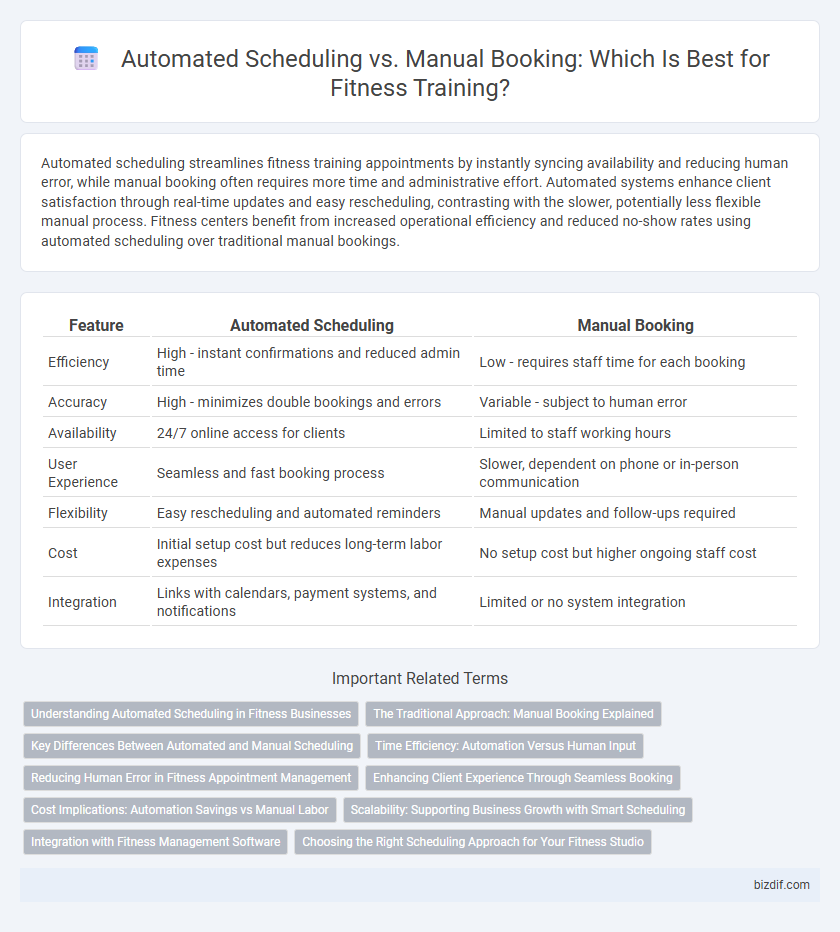Automated scheduling streamlines fitness training appointments by instantly syncing availability and reducing human error, while manual booking often requires more time and administrative effort. Automated systems enhance client satisfaction through real-time updates and easy rescheduling, contrasting with the slower, potentially less flexible manual process. Fitness centers benefit from increased operational efficiency and reduced no-show rates using automated scheduling over traditional manual bookings.
Table of Comparison
| Feature | Automated Scheduling | Manual Booking |
|---|---|---|
| Efficiency | High - instant confirmations and reduced admin time | Low - requires staff time for each booking |
| Accuracy | High - minimizes double bookings and errors | Variable - subject to human error |
| Availability | 24/7 online access for clients | Limited to staff working hours |
| User Experience | Seamless and fast booking process | Slower, dependent on phone or in-person communication |
| Flexibility | Easy rescheduling and automated reminders | Manual updates and follow-ups required |
| Cost | Initial setup cost but reduces long-term labor expenses | No setup cost but higher ongoing staff cost |
| Integration | Links with calendars, payment systems, and notifications | Limited or no system integration |
Understanding Automated Scheduling in Fitness Businesses
Automated scheduling systems in fitness businesses streamline class bookings and trainer appointments through real-time availability updates and integrated calendar management, reducing human error and administrative workload. These platforms leverage AI and cloud-based technology to optimize resource allocation, improve client experience, and enhance operational efficiency. By automating reminders, cancellations, and rescheduling, fitness centers increase customer retention and maximize staff utilization without manual intervention.
The Traditional Approach: Manual Booking Explained
Manual booking in fitness training involves clients or staff scheduling sessions through phone calls, emails, or in-person visits, relying heavily on human coordination and memory. This traditional approach often leads to scheduling conflicts, missed appointments, and time-consuming administrative tasks that reduce overall efficiency. Despite its drawbacks, manual booking allows for personalized communication and immediate adjustments, maintaining a human element in client interactions.
Key Differences Between Automated and Manual Scheduling
Automated scheduling in fitness training uses software to streamline class bookings, reducing errors and saving time compared to manual booking, which relies on human inputs and is prone to mismanagement. Automated systems offer real-time availability updates and instant confirmations, enhancing client convenience and operational efficiency. Manual booking often lacks integration with other management tools, leading to increased administrative workload and potential double-booking issues.
Time Efficiency: Automation Versus Human Input
Automated scheduling in fitness training significantly reduces time spent on appointment management by instantly matching client availability with trainers' open slots, eliminating back-and-forth communication typical of manual booking. This system leverages AI-driven algorithms to optimize calendar utilization, ensuring higher booking rates and fewer cancellations compared to human input. Manual booking, while personalized, often involves delays and errors that decrease overall operational efficiency in fitness centers.
Reducing Human Error in Fitness Appointment Management
Automated scheduling systems in fitness training significantly reduce human error by eliminating manual data entry and double bookings. These systems use algorithms to manage appointment availability, ensuring accurate time slot allocation and minimizing scheduling conflicts. Compared to manual booking, automation enhances accuracy and saves valuable administrative time, improving overall client experience and operational efficiency.
Enhancing Client Experience Through Seamless Booking
Automated scheduling streamlines fitness training appointments by providing real-time availability and instant confirmations, reducing wait times and minimizing booking errors. Clients benefit from personalized reminders and easy rescheduling options, leading to increased satisfaction and retention rates. Manual booking often lacks this efficiency, potentially causing miscommunication and delays that hinder a seamless client experience.
Cost Implications: Automation Savings vs Manual Labor
Automated scheduling in fitness training significantly reduces labor costs by eliminating the need for administrative staff to manage bookings manually. Software solutions streamline appointment management, minimize errors, and optimize resource allocation, resulting in lower operational expenses. Manual booking often incurs higher costs due to increased time consumption and the potential for booking conflicts that require staff intervention.
Scalability: Supporting Business Growth with Smart Scheduling
Automated scheduling streamlines fitness training appointments by handling high volumes of bookings effortlessly, reducing errors and double bookings common in manual systems. This smart scheduling supports business growth by allowing seamless scaling without the need for additional administrative staff. Fitness centers benefit from increased client retention and optimized resource allocation through scalable, automated processes.
Integration with Fitness Management Software
Automated scheduling seamlessly integrates with fitness management software, streamlining appointment bookings and reducing administrative tasks. Manual booking often requires duplicate data entry, increasing the risk of errors and time delays. Fitness centers benefit from automated systems by syncing client information, class schedules, and payment processing in one unified platform.
Choosing the Right Scheduling Approach for Your Fitness Studio
Automated scheduling systems streamline appointment management by reducing errors and saving time, which enhances client satisfaction and optimizes trainer availability. Manual booking allows for personalized interactions and flexible adjustments but demands more administrative effort and risks double-booking. Fitness studio owners should evaluate factors like client volume, staff availability, and technology proficiency to select a scheduling method that maximizes operational efficiency and supports business growth.
Automated Scheduling vs Manual Booking Infographic

 bizdif.com
bizdif.com